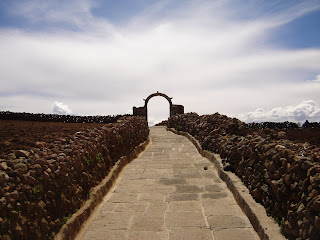Reportaje número 8, el 18-20 de noviembre
I know that most of these
reportajes have been filled with tales of joy and learning, so it is with a mind towards change that I write this report. Not to say, however, that this trip to Amantaní hasn't been fulfilling, fun, or worthwhile because, as I've said before, every time I travel to the

island I feel like a greater part of the community. This time was no different: I finally got to play soccer with the community's team (no easy feat at 4000 meters above sea level), have a mini-conversation in Quechua (no easy feat in an agglutinative language with a sinfin--”endless”--number of suffixes), and eat mashed
tarwi (an easy feat, actually: it tastes a little like tempeh). I though, though, that maybe, to veer from the course of sunshine and daisies a little bit that I would enumerate several of the challenges of teaching in Santa Rosa.
First of all, a lot of the teaching turns into, or is only successful in the company of , a little bit of community organizing. I mean to say that, without talking to parents, encouraging children to come, making sure every activity is both fun and informative at the same time, and overall making the work effective on a both micro and macro scale in a way that parents and community members can take note of becomes as much work as the actual lesson planning and teaching. Without a doubt, much of that is also true for teachers in a traditional school setting, however there are a few differences as well. For one, my pupils aren't required to show up, let alone stay or participate. There is no truancy officer waiting to take them back to the library, nor is there an evaluation system whose consequences they must fear. Because of that, I must keep them interested and engaged 24/7. Secondly, the children come to me after a full day of school already. They come out of desire, but they are already tired from their daily lessons. Thirdly, many of the teaching methods that you and I are accustomed to and that I utilize in the classroom are completely new to these children. In a Peruvian school, the pedagogical method relies on discipline, respect, and rote learning. I've only known these students for two and a half months; they've been learning in the Peruvian style for 3, 4, or 5 years already. It's ingrained. (I do want to make clear that I'm not judging nor criticizing the pedagogy of the school system here, just noting the difference and its effects on my 'classroom'). All in all, those seemingly minute differences form and shape the way this project continues.
Enough of those challenges for now, though. On Monday of this week, t

hree tourists participated in the Cultural Tour of Amantaní and brought A LOT of support and excitement to the library. We didn't have as many children as usual because of school vacations and end-of-year filed trips, probably only 7 or 8 showed up. With that handful, though, we were able to do a lot of fun things. We played a spelling game that involves a little bit of dodgeball and a little bit of Ultimate Frisbee; we read the story of
El Astuto Carnerito; and we had a lot of fun drawing and reading during free time. On Tuesday, using the excitement the kids have to draw, we had a competition. The contest went as follows:
-We broke up into three groups of three
-The scene to be drawn would be one of everyday life in Santa Rosa
-Everything had to be colored in and labeled in both Spanish and Quechua
-The drawings had to be completed in thirty minutes
The tension in the room was palpable, not to sound corny. Everybody was having a great time writing and drawing. There were shouts of, “How do you say ____ in Quechua/Spanish,” and “I need

that marker,” for the whole thirty minutes. No one was ready to ed when we did but, even so, the drawings turned out amazing. As a group, we went over and repeated every word on the pieces of over-sized construction paper. Afterwards, we used the drawings and the colors they contained to learn the different colors in English.
Challenges aside, these kids deserve all of the work put into this project.
 Well, folks, there it went, flying by: my last trip to Amantaní. Did you see it coming? No? Me neither. There is just a little over a week until I leave Perú and, unfortunately, I had to say goodbye to Santa Rosa, its people, and a bunch of beautiful children I've come to consider my own in some way.
Well, folks, there it went, flying by: my last trip to Amantaní. Did you see it coming? No? Me neither. There is just a little over a week until I leave Perú and, unfortunately, I had to say goodbye to Santa Rosa, its people, and a bunch of beautiful children I've come to consider my own in some way.















